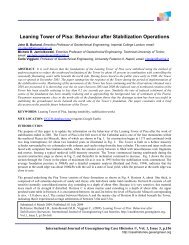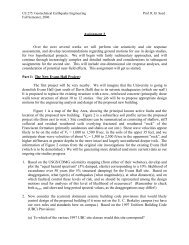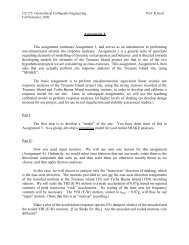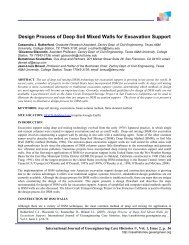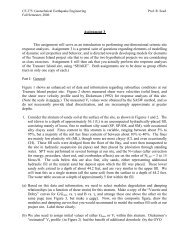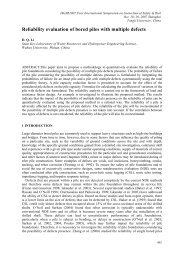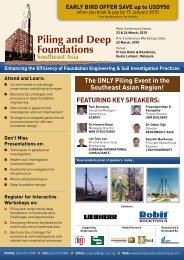Risk Assessment and Management for Offshore ... - GEOSNet
Risk Assessment and Management for Offshore ... - GEOSNet
Risk Assessment and Management for Offshore ... - GEOSNet
You also want an ePaper? Increase the reach of your titles
YUMPU automatically turns print PDFs into web optimized ePapers that Google loves.
data with available soil databases. This also applies to classification <strong>and</strong> index data in order to<br />
identify anomalous material types <strong>and</strong> stress conditions. Boreholes are 1-dimensional <strong>and</strong> must be<br />
tied to the seismic stratigraphy from 2D <strong>and</strong> 3D surveys. Tie-lines between geotechnical<br />
boreholes <strong>and</strong> exploration wells are required <strong>for</strong> extrapolation of geotechnical/geological<br />
in<strong>for</strong>mation from boreholes to the surrounding area, alternatively the boreholes should be placed<br />
at crossing points of seismic lines. Still in<strong>for</strong>mation about sediment properties such as P-wave<br />
velocity, is needed <strong>for</strong> proper correlation, since seismic data are recorded in time <strong>and</strong> not in true<br />
depth in metres.<br />
Strength anisotropy is an important factor in analysis of slope stability. The compressive<br />
undrained strength is generally higher than the direct simple shear strength <strong>and</strong> the extension<br />
strength is even lower. The anisotropy seems to be higher <strong>for</strong> low plasticity clays than <strong>for</strong> clays<br />
with high plasticity.<br />
Stress-dependency should be evaluated <strong>and</strong> included in the evaluation of strength parameters.<br />
At shallow depth, i.e. low consolidation stress, the normalised strength is higher than at greater<br />
depths below seabed.<br />
Strain rate has a significant influence on the undrained shear strength of marine clays <strong>and</strong><br />
should be accounted <strong>for</strong>. The applied strain rate in laboratory tests (a few percent per hour) <strong>and</strong><br />
the in situ strain rates under nearly static loading conditions <strong>and</strong> under wave loading <strong>and</strong><br />
earthquake loading vary considerably <strong>and</strong> could differ by several orders of magnitude.<br />
6 GEOHAZARD IDENTIFICATION – GEOHAZID<br />
The identification of geohazards will require an evaluation of existing site conditions <strong>and</strong><br />
assessment of the present or planned situation with respect to local <strong>and</strong> regional seabed stability<br />
<strong>and</strong> stability of wells, subsea structures, pipelines <strong>and</strong> plat<strong>for</strong>m foundations/anchor. The<br />
GEOHAZID is a systematic search <strong>for</strong> natural <strong>and</strong> human-induced processes <strong>and</strong> activities, i.e.<br />
triggering sources, which have a potential <strong>for</strong> trans<strong>for</strong>ming stable conditions into unstable<br />
conditions with harmful consequences. An expert team of experienced geologist, geophysicist <strong>and</strong><br />
geotechnical engineers with ability to communicate across discipline borders is thus required to<br />
identify relevant failure scenarios <strong>and</strong> associated triggering mechanisms. The GEOHAZID team<br />
should be assisted by drilling <strong>and</strong>/or facilities engineers, <strong>and</strong> be guided by a risk analysis expert in<br />
order to systemize <strong>and</strong> rank the scenarios <strong>and</strong> triggers in a way that allows quantitative risk<br />
analysis (QRA) to be per<strong>for</strong>med.<br />
Geohazard failure scenarios are basically assumed realisations of potential geomechanical<br />
failure modes that may involve or affect field installations or 3rd party assets based on the<br />
available in<strong>for</strong>mation <strong>and</strong> the knowledge, experience <strong>and</strong> intuition of the GEOHAZID team.<br />
Geomechanical modelling of the failure scenarios is required to evaluate the likelihood of<br />
occurrence <strong>and</strong> criticality in order to rank the different failure scenarios.<br />
The category of failure scenarios involving local seabed instability are related to unacceptably<br />
large displacements causing damage or production restrictions to equipment installed on the<br />
seabed; typically reduction of vertical, lateral or rotational bearing capacity of mat supports, piles,<br />
wells or pipelines/flowlines. Local seabed de<strong>for</strong>mations under or towards installations may occur<br />
due to changes in<br />
- Bathymetry <strong>and</strong> seabed gradients (sedimentation, erosion).<br />
- Pore pressure conditions/fluid flow.<br />
- Soil strain-softening under increased static <strong>and</strong> cyclic loading.<br />
- Generation of fluid/gas flow under or close to foundations (Tjelta et al., 2007)<br />
- Temperature increase around wells, manifold structures <strong>and</strong> pipelines causing gas hydrate<br />
melting followed by gas bubble expansion, fracturing <strong>and</strong> free water that will reduce the<br />
shear strength of the soil (Sultan, 2007).<br />
- Cratering caused by blow-outs/uncontrolled gas <strong>and</strong> shallow water flow<br />
The category of failure scenarios involving mass transport initiated within field development<br />
area comprises slumping <strong>and</strong> local sliding that affect installations either as loss of foundation area<br />
or as debris impact. Areas with increased gradient, caused by submarine channels, uneven<br />
166



